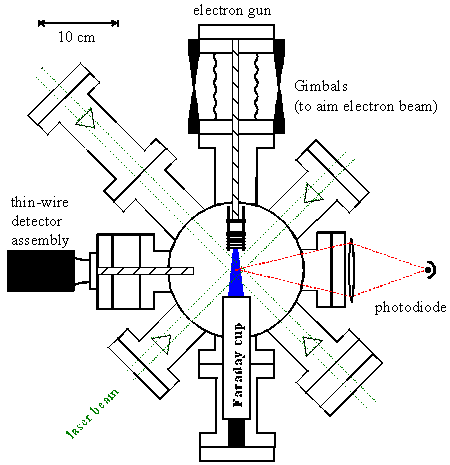Studying Electron-Atom collisions with an Atom-Trap
Magneto-Optical Trap (MOT) experiment
Why use a MOT?
There are two general techniques for measuring electron-atom collision cross sections:- Measure both how many events occur (i.e. how many photons are given off by excited atoms) and how many target atoms there are (i.e. what is the gas pressure). Combined with information about the electron beam, these number can give you the cross section.
- Measure the fraction of target atoms that suffer a collision due to the electron-beam passing through the target. Combined with information about the electron beam, knowing this fraction will give you the cross section.
The second method has been used before in crossed beam measurements. However, there is still some difficulty in knowing the overlap of the target atom beam and the incident electron beam. The trapped-atom approach eliminates this difficulty. The trapped atoms form a ball much smaller than the electron beam, thus only the current density at the very center of the electron beam needs to be determined.
How does a MOT work?
A diode-laser is tuned to be slightly below the the Rb (52S½ to 52P½) transition frequency. The laser is split into three counter-propagating pairs. Since the laser frequency is tuned below the atomic transition frequency, atoms will not absorb the light; unless the atom is moving toward the laser beam- in which case the light is Doppler shifted toward the atomic transition frequency. Since the atom absorbs momentum from the photon, it slows down. This provides a viscous cooling. A spring force, also neccessary to trap the atoms, is provided by applying an inhomogeneus magnetic field (B-field) to the trap. At the center of the trap, the B-field is zero, but increases in magnitude as you move away from the center. The B-field induces a Zeeman-shift in the atomic transition frequency- causing the atoms to absorb more photons as they move away from the center of the trap. Hence, atoms are pushed back towards the center of the trap.For further information on atom traps and their sick, evil uses visit the Atom Trainers.
How do you measure cross sections?
 The six lasers beams (one pair is out of the screen) combined with an
inhomogeneus magnetic field trap 106 atoms in a ball
about ½mm in diameter. The relative number of atoms trapped is
measured by the Rb (5p to 5s) fluorescence using the photodiode. The trapping
lasers are turned off, and the electron beam is pulsed on. After a short
delay, the trapping lasers are turned on. The decrease in Rb fluorescence is
proportional to the number of atoms lost from the trap due to being hit by an
electron. By knowing the electron current density at the trap and the fraction
of atoms lost from the trap various cross sections can be determined.
The six lasers beams (one pair is out of the screen) combined with an
inhomogeneus magnetic field trap 106 atoms in a ball
about ½mm in diameter. The relative number of atoms trapped is
measured by the Rb (5p to 5s) fluorescence using the photodiode. The trapping
lasers are turned off, and the electron beam is pulsed on. After a short
delay, the trapping lasers are turned on. The decrease in Rb fluorescence is
proportional to the number of atoms lost from the trap due to being hit by an
electron. By knowing the electron current density at the trap and the fraction
of atoms lost from the trap various cross sections can be determined.
Some experimental specs:
| Atoms in Trap: | 106 atoms at 100 µK |
| Electron Energy Range: | 0 to 500 eV |
| Electron Beam current: | 150 µA at 100 eV |
| Atoms studied: | Rb (total scattering, ionization, ionization out of laser excited level, heavy ion collisions) |
Recent Published Results
- Electron-impact ionization cross section measurements out of the 52P excited state of rubidium
-
M. L. Keeler, L. W. Anderson, and Chun C. Lin,
Phys Rev. Lett. 85 (2000) 3353-3356.
- Absolute Electron-Impact Ionization Cross Section Measurements Using a Magneto-Optical Trap
-
R. S. Schappe, T. Walker, L. W. Anderson, and Chun C. Lin,
Physical Review Letters 76 (1996) 4328-4331.
- Electron Collision Cross-Sections Measured with the Use of a Magneto-Optical Trap.
-
R. S. Schappe, P. Feng, L. W. Anderson, C. C. Lin, and T. Walker,
Europhys. Lett. 29 (1995) 439-444.
back to experiments list... back to home page